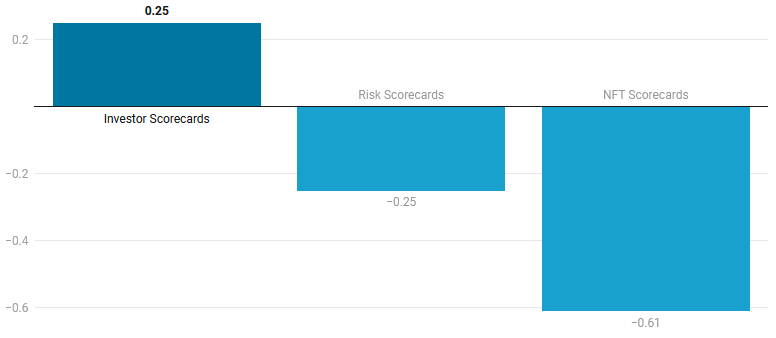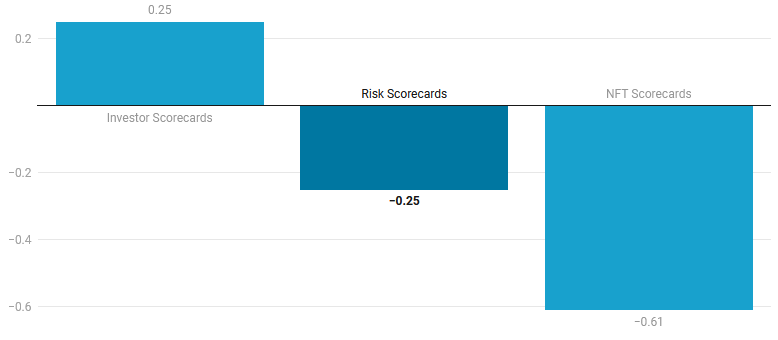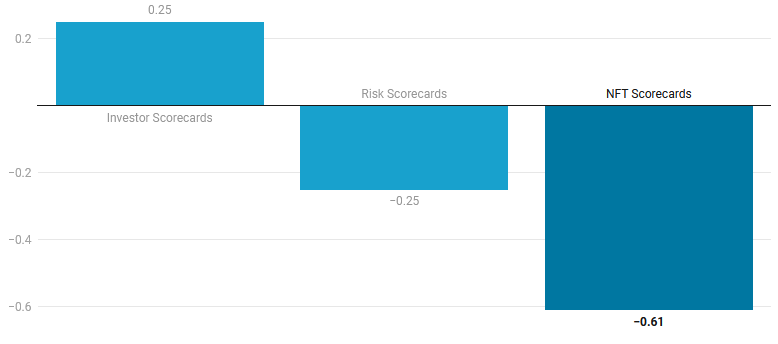
A few years ago, we developed our Blockchain Investor Scorecard, which was peer-reviewed and published, and has since been cited by dozens of researchers as an industry-leading framework for valuing crypto investments.
Then, we started to actually use it.
If you’re new, the scorecard is a set of 21 simple questions that we ask before investing in a crypto asset. Like investing in a company, we ask about the product, the team, the competitive advantage, and so on, rolling these up to a simple 1-5 star rating.
Like a Yelp review.
We followed up the Blockchain Investor Scorecard with a Blockchain Risk Scorecard (for evaluating crypto risk, not just the reward) and an NFT Investor Scorecard (for evaluating NFTs).
Our analysts have now spent several years producing these scorecards, which are all available for Premium Members.
Now for the $1 trillion question: are our scorecards useful for investors?
In other words, is a higher-rated crypto investment more likely to make money?
(On our Risk Scorecard, it’s the opposite: is a higher-rated (i.e., riskier) crypto investment more likely to lose money?)
Here are the correlations between our ratings and future performance:
Perfectly correlated = 1, perfectly uncorrelated = 0, perfectly negatively correlated = -1
In short:
- Investor Scorecards have been somewhat correlated with good investments,
- Risk Scorecards have been somewhat correlated with bad investments,
- NFT scorecards have not been helpful to investors so far (but they’re also brand new).
We were moderately pleased with these results, since the vast majority of our scorecards have proved useful for predicting future price movements. We’re not happy with our NFT scorecards, but we have some ideas there.
Important note: Our analysis measured the price when the scorecard was published, until today. Some were published years ago, some were published last month. Since we recommend holding crypto assets for at least 5 years, think of this as a “check-in.”
In other words, future performance of our top-rated investments may look different – even better, we hope. But so far, Investor Scorecards can be a useful tool in building wealth. Here’s why.
Investor Scorecards: Positively Correlated

Our analysis showed there is a small positive correlation (0.25) between our scores and performance, suggesting that higher-ranked investments tend to perform slightly better.
While you should do your own research, our scorecards are an excellent starting point, because we’ve done much of the research for you. Also, we present the research in an easy-to-read format – just two pages – and give you important categories to consider.
As an example, Ethereum (ETH), our highest-rated asset, has increased by a whopping +881% since we published the scorecard in 2020. Binance Coin (BNB), another of our top picks, has increased by an astonishing +1,366%.
Conversely, our lowest-rated assets tend to lose money. Compound (COMP), our lowest-rated pick, has plunged by -84%. Terra/LUNA, our second lowest-rated pick, spectacularly crashed and burned last year.
I’m picking the best examples, so there are plenty of high-ranked investments that have lost money as well. But again, it’s still early, and we’re in a bear market. Directionally, we’re pleased with these results, as we feel they’re adding real value to investors.
Risk Scorecards: Negatively Correlated

Our Risk Scorecards take the opposite approach, warning you about which crypto investments we find most risky. So here, the scores are in reverse: a higher score means a riskier investment.
Indeed, we found that the assets we rated riskier have tended to lose money. Again, we were pleased by this finding.
Investor Scorecards and Risk Scorecards are meant to go hand in hand: one measures potential reward, one measures potential risk. Ideally, before putting in your hard-earned money, you consult both.
Most of our Risk Scorecards have been published within the last six months, but even in that time, our lowest-rated (i.e., “safest”) asset, Ethereum (ETH), has grown by +50%.
Our second-highest-rated (i.e., second-riskiest) asset, Algorand (ALGO), is down -25%. (It has since been labeled a security by the SEC, adding greatly to its risk factor.)
Our riskiest asset, Ripple (XRP), shot up in price due to the recent court ruling (which I warned you is a mixed bag, at best). Time will tell the long-term performance of XRP, but I heartily stand by our rating: XRP is still very risky.
The bottom line is that our Risk Scorecards are a second useful tool for investors, as they give you an additional data point to consult before investing.
NFT Scorecards: Not Correlated

As excited as we are about the overall performance of our scorecards, the performance of our new NFT Scorecards has been disappointing.
Here, ratings were negatively correlated with returns – meaning our higher-rated NFTs actually went down in price, and vice-versa.
We think there are a number of reasons. First, this is our newest line of scorecards, so they really haven’t had time to prove themselves. Also, the NFT market has cratered in 2023, sending prices in all directions.
The bigger problem is likely that NFT value is harder to analyze. Whereas we can evaluate cryptos like companies, NFTs are more like art – and how do you value art?
Moreover, not all NFTs are pixelated art. We also have virtual real estate, tokenized assets, and so on … and we’ve quickly learned that trying to use one scorecard to rate them all is a crude and imperfect tool.
TLDR: we may need to go back to the drawing board on valuing NFTs.

A Valuable Tool in the Investor’s Toolkit
While you still want to do your own research, our scorecards are super-valuable tools to help you do that research more quickly – and give you an experienced opinion from the team that’s evaluated many, many investments.
In short:
- Crypto investments with high Investor Scorecard ratings have had a tendency to make money.
- Risky investments with high Risk Scorecard ratings have had a tendency to lose money.
- And NFT Scorecard ratings, so far, have not proved predictive.
The usual disclaimers apply: past performance does not guarantee future results. Remember that it’s still early (we recommend holding for a minimum of five years), and we hope these correlations will become even stronger over time.
Just as we open-sourced our original Investor Scorecard for the entire world to use, we want to be open about our results to date.We want to prove the value we’re providing for our Premium members, who support our continued research—and benefit from it.
We’re working to build a rigorous industry standard for valuing crypto investments, at a time when most people don’t even think of crypto as investments. So far, so good.
With your support, we’ll keep the good work coming. Consider joining as a Premium member, and get access to our entire library of scorecards.
Big thanks to Steve Walters and Mauricio Nogueira Silverio, who helped do the data analysis for this project – and to our team of analysts who have made the scorecards possible.

